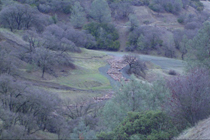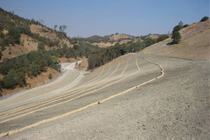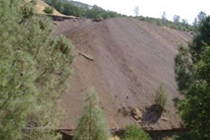Mining Program - Region 5 Success Stories
The Abbott and Turkey Run Mines, Lake County
The Abbott and Turkey Run Mines, Lake County
Quick Links
- Abbott and Turkey Run Mines
- Calfed Copper Mine
- Empire Mine State Historic Park
- Irish Hill Copper Mine
- Jamestown Mine
- Spenceville Mine
- Back to Success Stories page
Abbott and Turkey Run are inactive mercury mines located in Lake County approximately 24 miles west of Williams, California. The mines were operated from 1870 through 1971 by various parties, including Colorado Oil and Gas (COG) from 1958-1961. COG has been succeeded by El Paso Merchant Energy-Petroleum Company (EPME-PC). The mines discharged waste to Harley Gulch, a tributary to Cache Creek that flows to the Yolo Bypass and then the Sacramento and San Joaquin Delta, and potentially groundwater.
The main form of pollution from these mines prior to stabilization was mercury from piles of calcine waste that were eroding into the west branch of Harley Gulch. Mercury was eroded into the stream by storm water runoff at the Abbott mine where the majority of the tailings were located. The addition of mercury from mining is a major issue for the Sacramento River Watershed. The Central Valley Water Board adopted a total maximum daily load (TMDL) and Basin Plan amendment for mercury in Cache Creek, Bear Creek, and Harley Gulch, which were approved by the USEPA on 6 February 2007.
In 2007, EPME-PC retained a consultant to perform several site stabilization and erosion control activities at the site under USEPA oversight. Site activities included:
- Off-site disposal of approximately 1000 tons of mercury-impacted soil and debris
- Removing tailings from the west branch of Harley Gulch
- Placing compacted clay caps over all calcined tailings surfaces and the former Turkey Run ore pile locations
- Revegetation of capped areas
In 2009, EPME-PC submitted plans to maintain the stabilized mine site and investigate the wetland immediately south of the site for mercury contamination. Maintenance of the stabilization facilities and wetland investigation are currently ongoing.
EPME-PC and the Regional Board have forged a cooperative relationship toward successfully decreasing mercury loading from this mine site into the waters of the State. Progress has been made by stabilizing the site and implementing erosion control measures. However, further characterization is required to better understand post-stabilization recovery.






